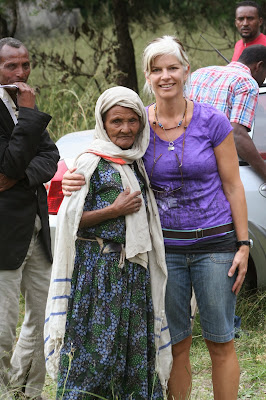
We ran medical clinics for three consecutive days, at the Canadian Humanitarian programs near Sheshemene, about two hundred kilmometres south of Addis Ababa.
On the first day, our bus stopped at the side of the highway, and we walked across the highway to the community "Health Clinic". The metal gate opened onto a grassy area with a large Warka tree. The tree sat like a wizened elder overseeing the activity. The gnarled and twisted trunk was the color and density of an elephant's leg. Its branches spread like an umbrella across the lawn, providing much needed shade for the many children that had followed us there.
There were buildings scattered across the lawn, as if they were dice--randomly thrown. The main buildings were concrete that had been painted butter yellow; the roof and doors were metal. Without electricity, the small carved window was the only light we had. There was no running water. The examination rooms were set up across the site. One was initially set up in the shade of a tree; however, when the sun lifted, they re-located to a nearby building made of sticks and tin, with a dirt floor, which we named, "the barn".
I was the assistant and runner to Ward, and we had a translator with us. His name was Ahmed (Ah-ha-med), and he was a nurse. He told me bits of his story throughout the day. He is part of a large family. His family is very poor, so instead of marrying and starting his own family, he told me that he is in service to his family. He works to support his parents and siblings. He is a remarkable man and I was humbled to work alongside of him.
We fashioned an exam table by joining a desk and a sewing-machine-table together. We covered it with a vinyl table cloth decorated with large green flowers. On a chair by its side sat Ward's tools: a stethoscope, an otoscope (which doubled as a flashlight when needed), some tongue depressors, alcohol swabs and hand sanitizer.
One-by-one they came. First adults and then children. We were not entirely sure what we had to offer. In fact, truth be told, we were pretty sure that we didn't have much of anything to offer. Still, they came.
A petite woman was brought to us. She waited in the chair outside our door, carrying only the piece of paper that she had been given. She was the quintessential Ethiopian woman. The lines carved into her honey-brown face revealed a map. Her cheeks sagged under prominent cheekbones, and her dry lips curled over toothless gums. Her bony shoulders heaved slightly when she breathed. She wore a long, flowered dress that was gathered at the waist, and hung loosely. A couple of wiry, silver ringlets escaped the cream-colored scarf encasing her head. Her tiny, dirt-stained feet were framed in orange plastic shoes.
Her complaints were many. Ward focused on two: frequent headaches and diarrhea. A stool sample was ordered, to check for ova and parasites; we had no idea if, when or how this test would be done. The test cost money, but the treatment was free. In an ideal situation, one might try to find the cause of an illness, and provide support for the removal/withdrawal/treatment of the cause. Here, that is just not possible. Just in this short afternoon clinic, we saw people with scabies, lice and worms--things that are rarely seen at home. We cannot eradicate this area of disease, it is endemic.
Nonetheless, as we sent this tiny elder off with a bag of Tylenol for her headaches, and a script for a stool sample - she walked a little lighter. I walked her back out into the grassy courtyard, and she took my hand and kissed it. I introduced her to Lauren, "Setlej", I said, and she also kissed Lauren on the back of the hand. I leaned down and gave her the traditional three-cheek kiss, and she grabbed me into a mama-bear hug. The universal language.
The thing that was amazing about this particular clinic was that our family all participated. Faven was taking photos of all the children who were in the CH projects, and getting height and weight on all patients. She worked with another volunteer, and there was a lot of laughing and hooting over there. They were virtually surrounded by members of the community, like paparazzi. Lauren worked with two nurses in the intake and triage; at first she was recording vitals, and throughout the day, she had learned to take some basic vitals, and was doing blood pressures (on the nurses) by the end of the day! Yohannes was escorting patients to and from the five clinic rooms that were spread across the yard. Both Yohannes and Lauren were also running between rooms to check on the doctors, and run prescriptions back and forth to the pharmacy, which sprawled on the veranda of the larger building, in hockey bags and Rubbermaid bins.
By the end of the day, we had all received many kisses, hugs and expressions of thanksgiving. Almost everyone was glad that we had come. Moreover, the fifteen of us volunteering that day (plus our translators) had worked as a team. There were moments when two or three of the doctors had to collaborate to figure out what was presented, and what could be done to support an individual.
It may, or may not have been about medical care. I'm still not sure. However, there was something going on. We worked together as CH volunteers, but we also collaborated with inspirational and dedicated Ethiopian leaders. It is these mentors, educators and visionaries who will remain in Ethiopia, attentive to the needs of each community. Something new has begun, that will affect all those involved: me, my family, and strangers in a country that is so beautiful that vision replaces words.

















No comments:
Post a Comment